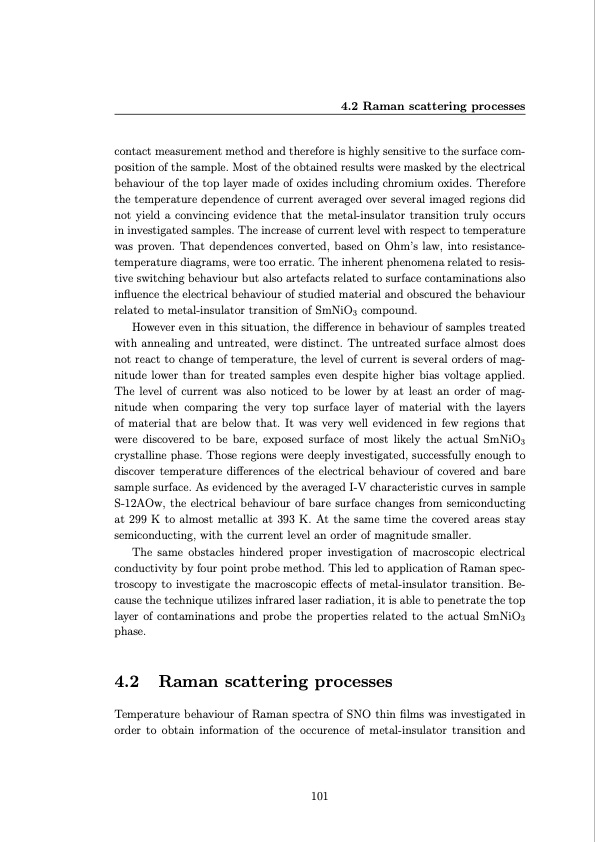
PDF Publication Title:
Text from PDF Page: 122
4.2 Raman scattering processes contact measurement method and therefore is highly sensitive to the surface com- position of the sample. Most of the obtained results were masked by the electrical behaviour of the top layer made of oxides including chromium oxides. Therefore the temperature dependence of current averaged over several imaged regions did not yield a convincing evidence that the metal-insulator transition truly occurs in investigated samples. The increase of current level with respect to temperature was proven. That dependences converted, based on Ohm’s law, into resistance- temperature diagrams, were too erratic. The inherent phenomena related to resis- tive switching behaviour but also artefacts related to surface contaminations also influence the electrical behaviour of studied material and obscured the behaviour related to metal-insulator transition of SmNiO3 compound. However even in this situation, the difference in behaviour of samples treated with annealing and untreated, were distinct. The untreated surface almost does not react to change of temperature, the level of current is several orders of mag- nitude lower than for treated samples even despite higher bias voltage applied. The level of current was also noticed to be lower by at least an order of mag- nitude when comparing the very top surface layer of material with the layers of material that are below that. It was very well evidenced in few regions that were discovered to be bare, exposed surface of most likely the actual SmNiO3 crystalline phase. Those regions were deeply investigated, successfully enough to discover temperature differences of the electrical behaviour of covered and bare sample surface. As evidenced by the averaged I-V characteristic curves in sample S-12AOw, the electrical behaviour of bare surface changes from semiconducting at 299 K to almost metallic at 393 K. At the same time the covered areas stay semiconducting, with the current level an order of magnitude smaller. The same obstacles hindered proper investigation of macroscopic electrical conductivity by four point probe method. This led to application of Raman spec- troscopy to investigate the macroscopic effects of metal-insulator transition. Be- cause the technique utilizes infrared laser radiation, it is able to penetrate the top layer of contaminations and probe the properties related to the actual SmNiO3 phase. 4.2 Raman scattering processes Temperature behaviour of Raman spectra of SNO thin films was investigated in order to obtain information of the occurence of metal-insulator transition and 101PDF Image | Investigation of metal-insulator transition in magnetron sputtered samarium nickelate thin films

PDF Search Title:
Investigation of metal-insulator transition in magnetron sputtered samarium nickelate thin filmsOriginal File Name Searched:
Bilewska_Investigation_of_metal_insulator_transition_in_magnetron_sputtered_samarium.pdfDIY PDF Search: Google It | Yahoo | Bing
Sulfur Deposition on Carbon Nanofibers using Supercritical CO2 Sulfur Deposition on Carbon Nanofibers using Supercritical CO2. Gamma sulfur also known as mother of pearl sulfur and nacreous sulfur... More Info
CO2 Organic Rankine Cycle Experimenter Platform The supercritical CO2 phase change system is both a heat pump and organic rankine cycle which can be used for those purposes and as a supercritical extractor for advanced subcritical and supercritical extraction technology. Uses include producing nanoparticles, precious metal CO2 extraction, lithium battery recycling, and other applications... More Info
| CONTACT TEL: 608-238-6001 Email: greg@infinityturbine.com | RSS | AMP |